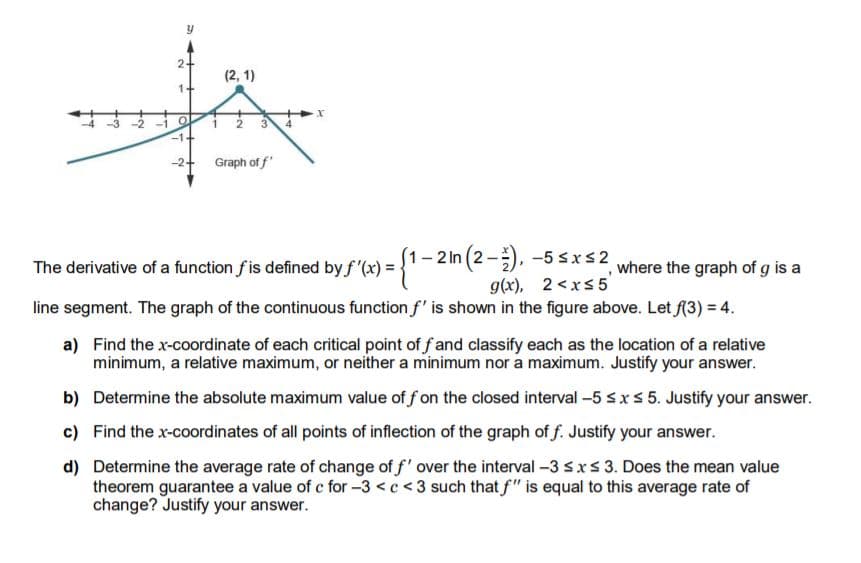(2, 1) Graph of f The derivative of a function fis defined by f'(x) =/1-2 in (2-), -5≤x≤2 where the graph of g is a g(x), 2
(2, 1) Graph of f The derivative of a function fis defined by f'(x) =/1-2 in (2-), -5≤x≤2 where the graph of g is a g(x), 2
College Algebra (MindTap Course List)
12th Edition
ISBN:9781305652231
Author:R. David Gustafson, Jeff Hughes
Publisher:R. David Gustafson, Jeff Hughes
Chapter6: Linear Systems
Section6.7: Graphs Of Inequalities
Problem 1SC: Graph: 3x+2y6.
Related questions
Topic Video
Question
This is an ungraded practice free response question!

Transcribed Image Text:(2, 1)
1+
Graph of f
1- 2 In (2-), -5 sxs2
g(x), 2<xs5
The derivative of a function fis defined by f '(x) = -
where the graph of g is a
line segment. The graph of the continuous function f' is shown in the figure above. Let f(3) = 4.
a) Find the x-coordinate of each critical point of f and classify each as the location of a relative
minimum, a relative maximum, or neither a minimum nor a maximum. Justify your answer.
b) Determine the absolute maximum value of f on the closed interval -5 sxs 5. Justify your answer.
c) Find the x-coordinates of all points of inflection of the graph of f. Justify your answer.
d) Determine the average rate of change of f' over the interval -3 sxs3. Does the mean value
theorem guarantee a value of c for -3 <c <3 such that f" is equal to this average rate of
change? Justify your answer.
Expert Solution
This question has been solved!
Explore an expertly crafted, step-by-step solution for a thorough understanding of key concepts.
This is a popular solution!
Trending now
This is a popular solution!
Step by step
Solved in 4 steps

Knowledge Booster
Learn more about
Need a deep-dive on the concept behind this application? Look no further. Learn more about this topic, advanced-math and related others by exploring similar questions and additional content below.Recommended textbooks for you

College Algebra (MindTap Course List)
Algebra
ISBN:
9781305652231
Author:
R. David Gustafson, Jeff Hughes
Publisher:
Cengage Learning

Algebra & Trigonometry with Analytic Geometry
Algebra
ISBN:
9781133382119
Author:
Swokowski
Publisher:
Cengage

Elementary Geometry For College Students, 7e
Geometry
ISBN:
9781337614085
Author:
Alexander, Daniel C.; Koeberlein, Geralyn M.
Publisher:
Cengage,

College Algebra (MindTap Course List)
Algebra
ISBN:
9781305652231
Author:
R. David Gustafson, Jeff Hughes
Publisher:
Cengage Learning

Algebra & Trigonometry with Analytic Geometry
Algebra
ISBN:
9781133382119
Author:
Swokowski
Publisher:
Cengage

Elementary Geometry For College Students, 7e
Geometry
ISBN:
9781337614085
Author:
Alexander, Daniel C.; Koeberlein, Geralyn M.
Publisher:
Cengage,

Algebra: Structure And Method, Book 1
Algebra
ISBN:
9780395977224
Author:
Richard G. Brown, Mary P. Dolciani, Robert H. Sorgenfrey, William L. Cole
Publisher:
McDougal Littell


Elementary Algebra
Algebra
ISBN:
9780998625713
Author:
Lynn Marecek, MaryAnne Anthony-Smith
Publisher:
OpenStax - Rice University